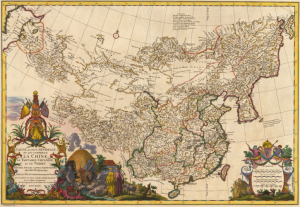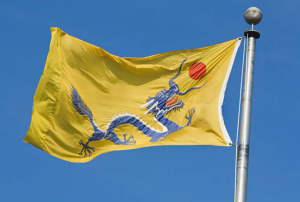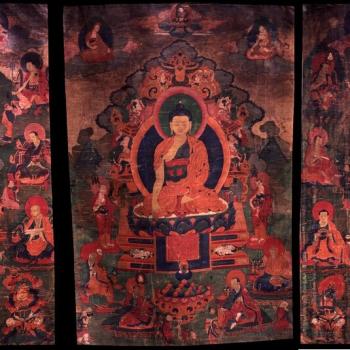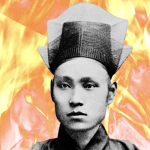
The greatest indicator of the Longhua jing’s success was the new group consciousness that developed among the heterodox sects. Gongchang’s organization did not last long enough to bask in what the scripture had achieved or to see this collective self-image develop. But both Wang Sen’s and Elder Sister Zhang’s did. They were both still extant in 1816 and were, remarkably, still governed by descendants of their founders. Even more remarkable, they were affiliated as two constituent members of a larger sectarian organization. In Qing records, it is called the Longtianmen jiao (龍天門教—Dragon Heaven Teaching School), apparently because their informant, Li Hexiu, belonged to the sect of that name founded by Lady Mi—mentioned in the Longhua jing itself—some centuries before. Whatever its actual name, this organization was clearly the continuation or descendent of the one Wang Sen had founded, showing that it had not only survived Wang Sen’s own persecution but also the intervening two hundred years of authoritarian Qing rule. Impressively, it had even survived the suppression of the Bagua rebellion two years before, despite using the same scripture and expressing the same anti-Qing attitudes as that movement. Hubert Seiwert reports in Popular Religious Movements and Heterodox Sects in Chinese History that their holy book also professed the coming of “a future world when a year will have eighteen months” (Seiwert 400), an idea clearly derived from the Huangtian jiao. In their adoption of this text, then, this organization was not only signaling a clear openness to the ideas and teachings of other sects but also demonstrating a shared sense of identity with other groups that held similar teachings.
But we do not have to rely merely on the example of shared scriptures, as the sectarians’ own testimonies show that they regarded themselves as belonging to a single movement comprised of all the Three Ages sects. Li Hexiu, when interrogated by Qing authorities, claimed that the Longtianmen organization had been founded by Patriarch Luo and that various sub-branches had been established by Wang Sen, Elder Sister Zhang, Lady Mi, and others. Thus, by the nineteenth century, the narrative promulgated by the Longhua jing had taken firm hold. Patriarch Luo, who in life never associated with the Three Ages sects and rejected Maitreyan messianism, was remembered as the founder of a grand millenarian tradition and of Wang Sen’s sectarian organization in particular. A broader sense of unity had erased from memory the fact that, during the Ming, the sects had been established independently and sometimes had a more exclusive sense of their own importance. By this time, as Seiwert says, “[e]ven if they certainly did not belong to a unified organization, there was a strong consciousness of belonging together that prevailed through the centuries” (Seiwert 401-02). Sects also tended to recycle the same old names for themselves, such as Hongyang jiao and Dacheng jiao, even when they had no direct connection to the earlier groups bearing those names, suggesting that they felt a kinship with them based on ideas rather than direct affiliation. The Longhua jing’s aim, a unity of purpose and identity if not organization, had been largely achieved in the century and a half since the end of the Ming.
The sects certainly needed that new sense of united purpose and solidarity. It is probably no coincidence that the Longhua jing, with its message of sectarian brotherhood and unity, came along when it did. For these were tumultuous times, the most tumultuous that a Chinese person of the era could know. For the dynastic cycle was turning again. In 1644, the Manchus entered Beijing and established the Qing Dynasty. The Ming fled beyond the Yangtze and endured in a rump form for a decade and a half, but the Qing crushed the last remnants of the old dynasty in 1661 and 1662. Over the next two decades they would claim all of China for themselves. Thus, the birth of the Qing and its battles with the remnants of the Ming covered the period during which the Longhua jing was written. Nanjing was the capital of the southern Ming for a time. It was also, along with Jiangsu the base for Gongchang’s sect. Thus, the Longhua jing was written on the frontlines, as it were, of the dynastic struggle between Ming and Qing. In this chaotic climate, it is no wonder that unity of some kind looked so appealing to Gongchang and his followers. And perhaps this particular prophet actually did have a sense of things to come, for sectarian unity would be a prerequisite for survival under the new regime.
While the Qing did its best to adopt Chinese customs and ensconce itself in the Chinese cultural framework, it in some sense never truly ceased to be an occupying power. Even as Manchuria and China became one nation, the rulers of the Qing knew that most of the population would always see them as foreign interlopers forcibly inserting themselves into the dynastic scheme. Thus, a sense of paranoia governed the dynasty’s relations to its subjects, which often translated into more draconian controls on the populace. Dissent of any form could not be tolerated. This obviously included the sects, which stood outside the approved religious establishment. From the middle of the eighteenth century, they faced sustained and severe persecution. As a result, the sects themselves became decidedly anti-Qing.
Gone were the days when the sectarian baojuans could wish long life to the reigning emperor without compromising their eschatological vision. The old prophecy of a restoration of the rightful dynastic lineage now reappeared. For the first time, it even found a place in the Three Ages system itself. Except, there was one crucial difference. While the prophecy-inclined had long awaited the Han Dynasty’s providential restoration, would-be prophets now proclaimed instead the return of the Ming. This can be seen in the scripture shared between the Bagua and Longtianmen movements, the Sanjiao yingjie zongguan tongshu (三教應劫總觀通書—Complete Overview of the Three Teachings on Responding to the Final Calamities), which asks, “When the barbarians have come to their end, who will ascend the throne?” and then answers its own question with “the Great Ming Niuba 牛八” (qtd. in Seiwert 399). Not only is the “Great Ming” explicitly promised to retake the throne, but the two characters that make up niuba, when added together, form the character “Zhu” (朱), the family name of the Ming’s ruling house. It seems that, even when long dead, the Ming Dynasty could not untangle itself from the air of messianic prophecy that had followed it from birth.
One enterprising sect leader in Sichuan brought together all of the popular eschatological ideas into a single grand vision. This was Liu Qi. He had originally joined a sectarian organization founded by a man named Zhang Baotai. Zhang had founded a sect using the Dacheng jiao name in Yunnan in 1681, the same year Qing forces finally subjugated the province, and managed to establish branches throughout the whole of the old Shu region. After facing intense government persecution, he died in 1741 and his sect split into three. His son Zhang Xiao became leader of the Yunnan branch, a woman named Wei Wangshi took over the Guizhou branch, and Liu Qi gained control of the branch in Sichuan.
Liu Qi renamed the Sichuan group the Sanchuan jiao (三船教—Three Boats Teaching) and further divided it into three separate organizations that functioned semi-independently to better escape detection by Qing authorities. His message was a hodge-podge of every millennialist idea current in China at the time. Thus, he preached the Three Ages and said that he himself was Maitreya (and also the reincarnation of Zhang Baotai). But he also preached the coming of the long-awaited messiah named Li—Liu called him “Li Kaihua.” He also foretold the restoration of the Ming Dynasty, going so far as to appoint an apparent Ming descendant named Zhu Hongsheng to lead one of the three branches of his sect; Zhu subsequently made use of the name “Zhu Niuba,” the messianic title of the coming Ming Emperor also found in the Sanjiao yingjie zongguan tongshu.
At the same time, Liu Qi somewhat contradictorily suggested that Li Kaihua himself would be the future Ming Emperor. As Seiwert notes, Liu Qi claimed that Li “had appeared in the person of a certain Su Junxian 蘇君賢 who would be the emperor restoring the Ming dynasty” (Seiwert 408). How a figure surnamed either Li or Su could be the restoring emperor of the house of Zhu is anyone’s guess—although given that Su Junxian appears to mean something like “Virtuous King of Resurrection,” it could merely be a title—but Liu was also probably remembering the ancient prophecy of Liu saving China whilst being aided by Li. In that case, as a Liu, he would need a Li by his side. And why should that person not be Emperor, if Liu himself had already taken the greater role of Maitreya?
It gives me some satisfaction to note that, some sixteen hundred years after the Three Kingdoms period, there was once again a movement based in Sichuan and headed by a man named Liu that opposed a northern regime and championed the restoration of the previous dynasty in decidedly millennialist terms. But Liu Qi was in no sense the equal of such an illustrious predecessor. His sect was suppressed in short order by the Qing authorities after they infiltrated Wei Wangshi’s organization and learned of her associate’s seditious activities. Liu Qi was executed, as were Wei Wangshi and Zhang Xiao, despite neither of them taking part in Liu Qi’s anti-Qing efforts. Indeed, the Qing took to exterminating the remnants of the Zhang Baotai’s sect with more than their usual severity. Not only did they desecrate Baotai’s corpse—standard operating procedure for imperial sect suppression—but showed a greater-than-average thoroughness in rounding up and burning all the sect’s baojuans. So thorough were the authorities, in fact, that not a single holy text from this group has come down to us.

Still, for how wildly successful the Qing was in uprooting this sect, its example shows how widely disseminated sectarian ideas were and how vast the wider movement had become. Zhang Baotai and Liu Qi showed no knowledge of the baojuans being used in the north like the Sanjiao yingjie zongguan tongshu, but often preached the same ideas found there, like that of a future emperor named “Zhu Niuba.” The ideas of Three Ages sectarianism had now penetrated so far into popular consciousness that, for all its efforts at eliminating various sects, the Qing could simply not stamp out the ideas which animated them. And, of course, if Liu’s example shows anything, it is that Sichuan remained a hotbed of millennialism even at this late time. Indeed, millennialist rebellion would break out in the area again in the 1790s.
The Qing suppression of the Three Boats sect, carried out in the 1740s, showcased the lengths the dynasty would go to destroy all forms of potential opposition. But later events would also show the limits of its abilities to root out the source of religious dissent, the millennialist ideas wafting unimpeded through the atmosphere of popular thought. The dynasty’s wider ideological failure was made clear by the millenarian rebellions that the Qing repeatedly had to fight in the latter part of the eighteenth century. One of these, the Bagua rebellion of 1813, proved to be one of the Qing government’s greatest crises. The Bagua movement had its origins in another Liu, Liu Zuochen, who founded the initial Bagua sect sometime before 1700. After his death, his son Liu Ruhan adopted the organizational method proposed by both the Jiulian baojuan and the Longhua jing and divided the sect into eight branches modeled on the eight trigrams, hence the name (Bagua 八卦 means “Eight Trigrams”). The Liu family’s sectarian associations came to the attention of Qing authorities several times over the next century, mostly due to the Lius’ repeated bids for high office. But the officials proved to be uncharacteristically lax in their investigations and the Lius were, each time, able to slip through the net of suspicion.
Using those new organizational methods proposed by the baojuans and put into place by earlier sectarians like Yin Ji’nan and Wang Sen, the Lius were able to expand their sect throughout the north and gain vast sums of revenue. They apparently adopted a very decentralized model where the Lius collected dues from outlying congregations but otherwise let them function without oversight. As with Liu Qi, this was designed to allow the family to escape detection. Ultimately, however, it was their undoing. A leader of their organization in Shandong named Wang Zhong was apprehended by authorities in 1772 and this led to the whole network being revealed. The Qing government tried its usual tactics, executing the main leaders and banishing the rest to far-flung provinces, but failed to root out the sect. Bagua branches continued to profess loyalty to the exiled Liu family. They also remembered the victims of the government’s persecution as martyrs, such that during the 1813 rebellion, the rebel leader Li Wencheng even claimed to be the reincarnation of ill-fated Wang Zhong.
Still, the government’s efforts had been devastating to the organization’s unity and it splintered into several independent branches. It was only in the 1800s that Lin Qing, the leader of a previously quite minor branch, began his attempt to reunite the various remaining sects into a single movement. Not only did he earn the loyalty of several of them, he even managed to attract sects outside the Bagua lineage, such as Piaogao’s venerable Hongyang jiao, into his rebuilt Bagua organization. As Seiwert says, “Lin Qing’s new Bagua jiao was a short-lived network of various sects united by the common expectation of great changes, the vigour and skill of its leadership, and finally by the pressure of rebel forces to join the uprising” (Seiwert 422). With this impressive achievement under his belt, Lin joined with Li Wencheng to begin plotting rebellion. They then established their millennialist message: Li Wencheng was Wang Zhong reincarnated, the restorer of the Ming Dynasty, and also probably the long-foretold messiah surnamed Li. Meanwhile, as Seiwert explains, “Lin Qing himself was regarded as incarnation of Liu Zuochen, the founding patriarch of the Bagua tradition, who was said to be a manifestation of Maitreya Buddha” (422). In this fashion, they both tied themselves into the cherished past of both the Bagua sect and China as a whole, while also acting as the heralds of a glorious future. After a few years laying the groundwork, the duo launched their uprising in 1813.
The rebellion spread across several northern provinces but is chiefly remembered for a single daring action, the assault on the capital. During this attack, rebel forces targeted the Qing Emperor and managed to penetrate the Forbidden City itself before being repulsed by imperial forces. Afterward, the rebellion was swiftly suppressed. But the audacity of the assault on the imperial residence shook the dynasty to its core. The Qing responded with even harsher persecutions. They found some success in blunting the power of the Three Ages sects to stage rebellions. But they could not stamp out the wider networks of anti-Qing sentiment these movements had encouraged nor blunt the millennialist expectations they had nurtured in the populace. The greatest uprisings against the dynasty were still in the future. While the resolutely millennialist Taiping rebels relied on the bizarre Christian apocalypticism of Hong Xiuquan rather than on any form of Three Ages belief, they clearly took advantage of the climate of millenarian anticipation that the Three Ages sects had fostered. And while the Boxers were not primarily a religious movement, they came out of the sectarian heartland of Shandong and made use of anti-Qing networks that surely owed part of their existence to the earlier sects.
All the while, the Qing continued to struggle in its efforts to exterminate the belief in the Unborn Mother and the Three Ages. They never succeeded at this aim, and new sects professing these ideas continued to arise throughout the dynasty’s lifetime. The most famous of these is the Yiguan dao (一貫道—Way of Continuous Unity), a descendant of Yin Ji’nan’s original sect that was founded around 1877 by Wang Jueyi and today enjoys the largest membership of any Three Ages group. Its teachings, as summarized by Seiwert, are these:
The central deity is the Unborn Venerable Mother (Wusheng Laomu) who as compassionate deity wants to rescue her children from the world of suffering. During the two former periods, Qingyang and Hongyang, she has sent down messengers to reveal the heavenly truth, but only four yi (hundred million) of her children have returned to the native place so far. Presently we are in the Baiyang period and the Mother has sent Maitreya to appear in human form and rescue the remaining ninety-two yi. The founder of the Yiguan dao, Wang Jueyi 王觉一, is said to be a manifestation of Maitreya and accordingly it is the teaching of Yiguan dao that will save humankind. (Seiwert 427-28)
This is, we see, the standard message that has been passed down for Three Ages sects throughout the last several centuries. The Unborn Mother is the supreme deity, there are three time periods with the traditional names. There is a concept of progressive revelation, with messengers and prophets being sent down throughout the previous ages to bring the saving truth to humanity. And again, it is only in the third period that the mission will be completed, the full truth revealed, and the work of salvation brought to completion.
The chief new development in Yiguan belief is that the Unborn Mother has now completely displaced the Primordial Buddha. Whereas the two depictions of God had coexisted uneasily in earlier sectarian belief, only the Mother remains, reflecting a long evolution over the Qing period wherein the Primordial Buddha dropped increasingly out of use as an embodiment of the divine. Otherwise, Yiguan doctrine lives up to its name by showing remarkable continuity with the Three Ages sects of the Ming and Qing Dynasties. It also contains all the Joachimist elements that we discovered in the beliefs of those sects. Even the fact that they say the Third Age has already been inaugurated by their founder recalls the similar claim made by Joachimites such as Peter John Olivi, who declared that the Third Status began with St. Francis of Assisi, or Fra Dolcino, who thought that his own sect’s founding had launched the final era. But more words on that must wait until we have discussed the impact of Christianity in Chinese thought during this time period.
Despite staging a failed rebellion against the Qing in 1883, the Yiguan dao survived the dynasty itself and went on to become the most successful of the modern Three Ages sects. Despite renewed persecution under the People’s Republic, it continues to endure and still makes international headlines from time to time. But it is only one of a myriad of Three Ages groups which have proliferated in the late nineteenth and twentieth centuries; the Wikipedia page for “Chinese salvationist religions” lists a number of them. Incidentally, Wikipedia also has a short article on the Chinese Three Ages concept, which is there referred to as the “Three Suns”—favoring a more literal but potentially misleading translation of the term sanyang (三陽); as I have noted previously, it does not seem that any sectarian actually believed in three separate suns. I’m happy to report that, as of the time of this writing, Joachim of Fiore is listed under the “See Also” section of that page. Adding his name there some years ago was one of my first public forays into discussing the parallels between his thought and that of the Chinese sectarians.
At any rate, Three Ages belief is alive and well in Eastern Asia, even as it sticks to its old habit of drawing the ire of the Chinese government. But it also now competes with a rival eschatological movement, the uniquely Chinese brand of Christianity that has sprung up over the last two centuries. In our next entry, we will look at Christianity’s re-entry into China, its subsequent progress through the centuries, and what this means for possible connections between Joachimist thought and Chinese sectarianism.
But as a final word on the later development of the Three Ages sects, we can see that the Longhua jing’s effort to encourage unity between them was wildly successful. As Seiwert observes, “During the Qing dynasty sectarian differences based on certain scriptures and lines of transmission gradually lost their significance” (433). Even where they may have differed on certain minor details of belief, sectarians in the Qing era had a stronger sense of being co-religionists, of all believing the same thing, than had previous sectarians. Quite ironically, the Qing Dynasty did much to bring this about through their constant persecutions. By focusing on their shared ideas as a source of unity, the sects were able to ensure that their broader religious identity would endure even as organizations were uprooted and lineages exterminated. Despite the failure of their rebellions and the deaths of their prophets, the story of these sectarians during the Qing is one of survival. It was during these years that the Three Ages movement not only outlasted its imperial adversary but truly became what scholars like Overmyer and Seiwert have long called it, the fourth great traditional religion of China.
Works Cited
Seiwert, Hubert. Popular Religious Movements and Heterodox Sects in Chinese History. Leiden: Brill, 2003.











